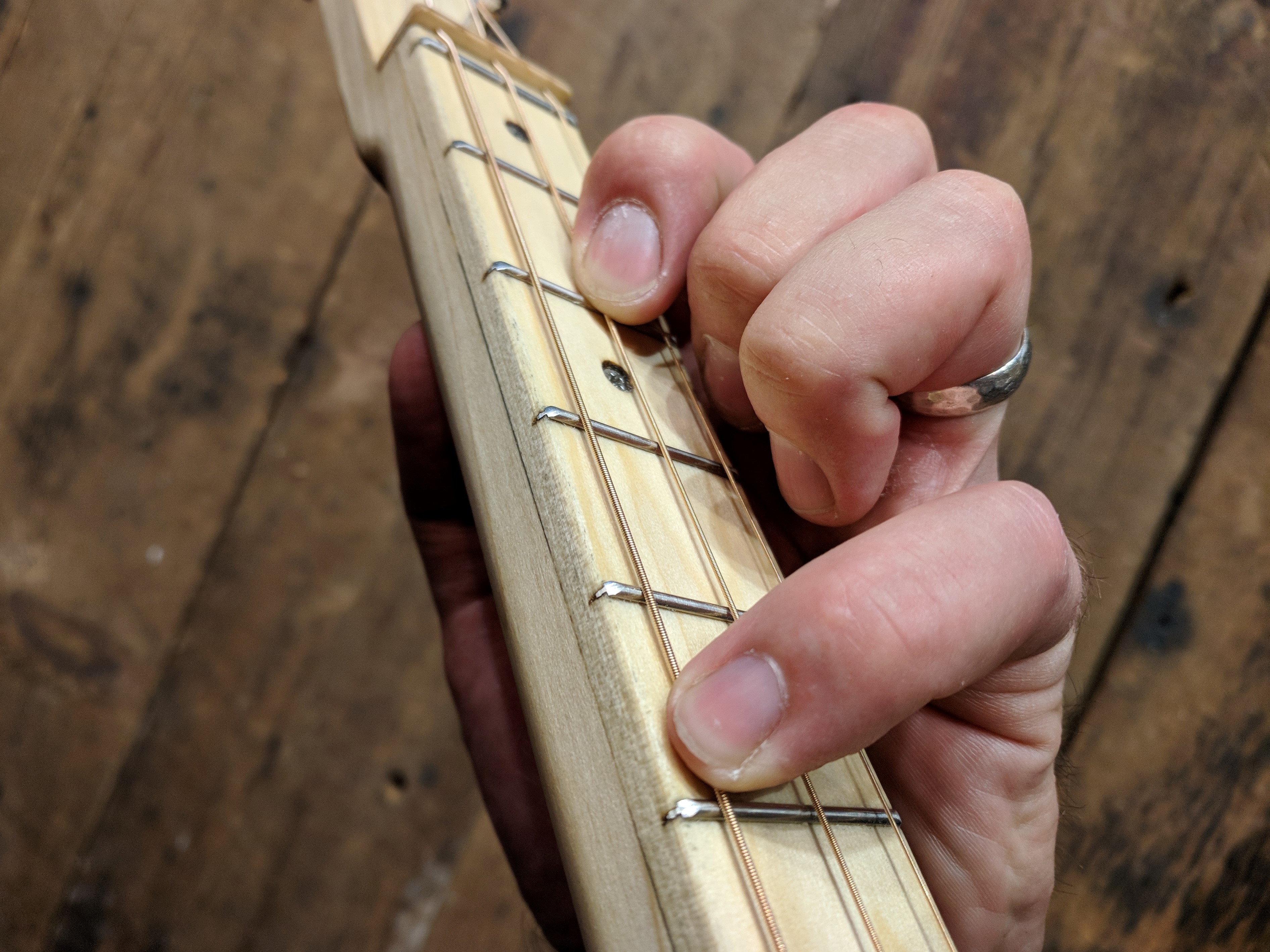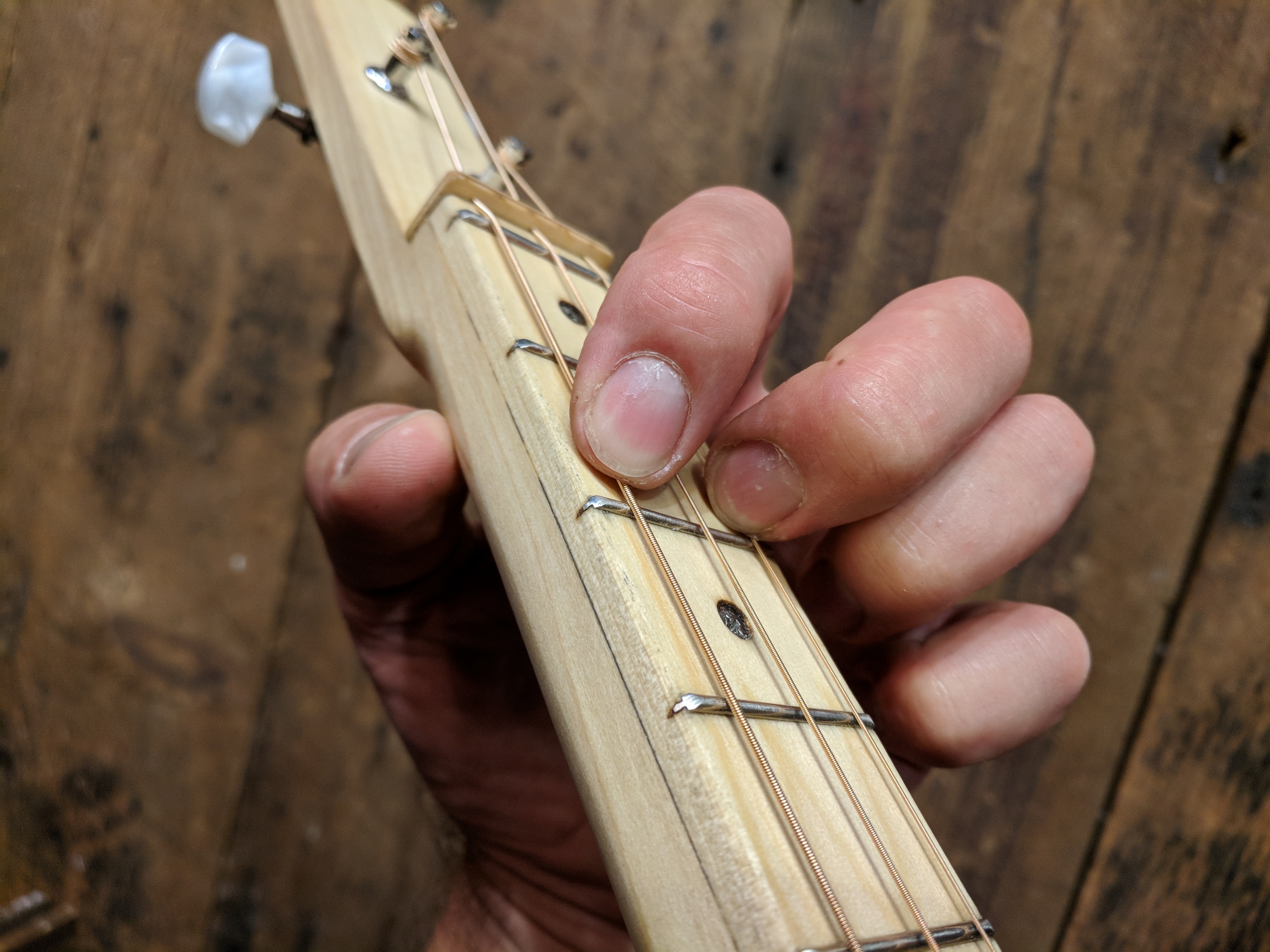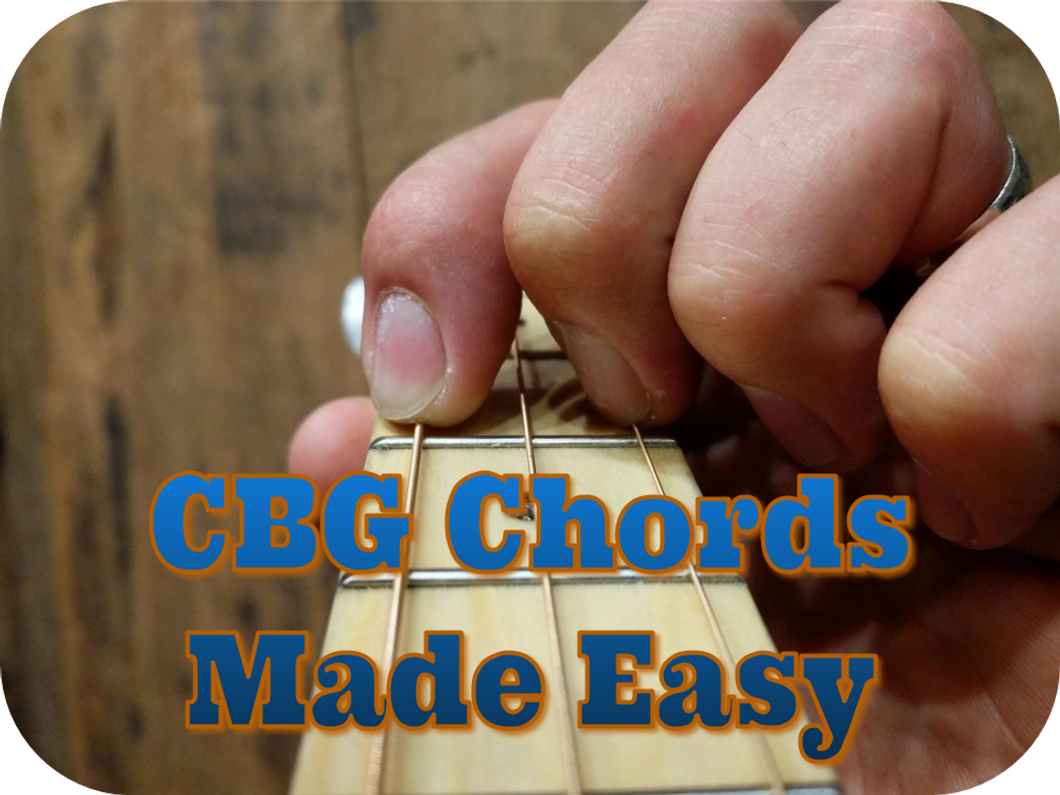3-String Cigar Box Guitar Chord Forms Made Easy: The Ultimate Guide
Want to learn new chords for your 3-string cigar box guitar?
Interested in playing your cigar box guitar with more than just one finger?
In this article, you'll learn...
- How to play the most valuable chords on a cigar box guitar tuned G-D-G
- What a chord form is
- How to play a chord, so it sounds good
- How to read a chord chart
- How to play the most popular chord progression
- How to mirror, or flip chord forms
- Where to learn more chords to become a well-rounded player
Let's get started by learning the most popular chord progression, ever.
The most popular chords
Here are the three chords that make up the most popular chord progression.
G Major Chord

Using the third finger on your fretting hand, fret the low (thickest) string at the fourth fret.
Leave both the middle string and high (thinnest) strings open.
Strum all three strings.
What you hear is a G major chord.
C Major Chord

Next, using your fourth finger, press the lowest string to the fretboard right behind the fifth fret.
Press the middle string to the fretboard right behind the second fret using your first finger.
Leave the high string open and strum all three strings.
That's a C major chord.
D Chord

Now use your first finger to press the lowest string behind the second fret, and your second finger to press the highest string down, also behind the second fret.
Leave the middle string open and strum all three strings.
You’ve just played a D chord.
To hear the chord progression resolve, play the G chord again.
Those three chords and the variations thereof represent the majority of western music -- from blues, to rock, to classical -- played over many, many lifetimes.
But what exactly is a chord form, anyhow?
What A Chord Form Is
A chord form is how a chord is configured on the fretboard.
In the case of 3-string cigar box guitars, a chord is comprised of three notes.
The chord form indicates where to put your fingers on the fretboard to play the three notes of the desired chord.
While one chord can be played with multiple forms, for the purpose of the exercise above, we focused on one form per chord.
How To Play A Chord
Playing a chord so that all the notes ring clearly takes a little work.
To get a handle on how to play a chord, let’s start with which fingers you use to play the notes.
For a 3-string cigar box guitar, you’ll never use more than three fingers to play a chord; sometimes only one finger, at that.
Which fingers you use is a personal preference, but this guideline will help clear things up a bit.
Regardless of which strings are fretted,
--> notes on lower frets of a given chord form are played mostly with your first or second finger,
--> while notes on higher frets in that same chord form are often played with your third or fourth finger.
Each fretted note should be played by firmly pressing the string down right behind the fret.
Pressing the string too far back from, or right on top of, the fret can produce a buzzy or muddy note.
Take care to arch your fingers so that the other strings may vibrate.

Arch your fingers so that they do not mute other strings takes practice.
Regular practice also develops calluses on your fretting fingers.
Until those calluses develop, your fingers may be a bit tender when practicing your chords.
Fear naught!
Regular practice develops calluses, strengthens fingers, and establishes muscle memory for improved chord forms.
And before you know it, you'll play a variety of chords without even thinking about it.
Now that you know what a chord form is and how a chord is played, let’s dive into how to read a chord chart.
How To Read A Chord Chart
On C. B. Gitty chord charts, three vertical lines represent the three guitar strings, with the lowest (thickest) string on the left.
Dots on the vertical lines represent where that string is fretted to play a note in a given chord.
As in the example below, those dots also include suggestions on what finger to use to fret the notes.

In the example above, each note of the chord is labeled above the string on which it is played.
So as you can see, reading a 3-string cigar box guitar chord chart is a cinch.
And since you now know how to read one, and know how to play the chords on them, here’s some insight on how chord forms can be mirrored (or flipped) on a cigar box guitar tuned G-D-G.
Mirrored (Flipped) Chords
On a cigar box guitar tuned G-D-G, chord forms can be flipped, or mirrored, to play the same chord with a slightly different sound.
Think of mirrored chord forms this way...
The low and high strings are the same note (G).
So no matter what number the fret, playing the same fret on the low and high strings produces the same note, only with different pitches.
Try it out.
Play a note at the second fret on the low string, and you’ll play an A.
Similarly, play a note at the second fret on the high string, and again you’ll play an A.
Taking this a step further, let’s look at the C major chord learned earlier.

--> You fretted the fifth fret on the low string,
--> fretted the second fret on the middle string,
--> and played the high string open.
From low to high, you played C, E, and G.
Now, play

--> the low string open,
--> fret the middle string at the second fret,
--> and fret the high string at the fifth fret.
From low to high, you played G, E, and C.
See how the chord is mirrored?
Mirroring chords is a great way to change the sound of what you play without learning a complex series of forms and where to play them on the fretboard.
Pretty cool stuff, right?
So where you can find a library of chord forms to play nearly anything your heart desires on a cigar box guitar?
Don’t worry.
We got you.
Where To Learn More Chords
At C. B. Gitty, we have a wealth of resources for you to learn how to play your cigar box guitar, including the gorgeous and instructive chord charts seen above.
Designed by Ben "Gitty" Baker, the chart pictured above includes a purpose-built diagram that shows the locations of all the "one-finger" power chords, along with 20 additional Major, Minor and Seventh chords.
Together, these chords will allow you to play a vast array of favorite and traditional songs.
We've also got beautiful and informative charts, hand-drawn by the King of cigar box guitars, Shane Speal, and reproduced in both vintage-poster (above) and blueprint- poster (below) styles.
And whether you're drinking a little morning coffee or a well-deserved nightcap, you can study the same chord forms on a 14 oz mug.
More Resources
This article is only the beginning.
Take your cigar box guitar education even further with the library of instructional chord charts created and published by the experts at C. B. Gitty, along with the treasure trove of how-to-play songbooks.
Now pick that cigar box guitar back up and get strumming.
The Wrap-Up
You made it to the end!
There's a lot in this article to take in, and with a little practice, it all will become second nature.
Here's what you learned...
- How to play the most valuable chords on a cigar box guitar tuned G-D-G
- What exactly a chord form is
- How to play a chord, so it rings clear and true
- How to read chord forms on a chord chart
- How to play a chord progression you'll find in nearly every style of music
- How to mirror chord forms
- Where to find the resources to become a well-rounded player
And speaking of resources, click the links below to get your own...
Open G "GDG" Essential Cigar Box Guitar Chords Poster
Three-string Open G Chord Poster for Cigar Box Guitar, Hand-Drawn By Shane Speal
Blueprint-style 3-string Open G Chord Poster for Cigar Box Guitar, Hand-Drawn By Shane Speal
Coffee Mug: Cigar Box Guitar Chords & Scales - Big 14 oz
If you need help finding resources to learn how to play your cigar box guitar, contact us at support@cbgitty.com, and we'll get right back to you.
Must-Reads...
Continue getting better at playing chords and understanding your cigar box guitar with the following must-read articles.
Set Aside 20 Minutes Each Day To Do This
Want to learn how to play chords on your 3-string cigar box guitar? Use flashcards 20 minutes a day.
That’s right. Those things you used to learn your multiplication tables and other grade school lessons.
As you're about to see, they're not just for kiddos.
With a handful of flashcards and a short amount of time devoted each day to use them, you can master 3-string cigar box guitar chords.
Keep reading about setting aside 20 minutes each day to conquer 3-string cigar box guitar chords.
What Is Scale Length & Why Does It Matter?
What is scale length and why should you care?
Given the “no rules” mantra in the cigar box guitar community, the term scale length looks an awful lot like a rule, doesn’t it?
And if there are no rules to building cigar box guitars – a big reason why they’re so much fun – then why do you need to learn about scale length?
Well, rather than bog you down with confusing terminology and the science of it all, what you’ll find here is the simple definition of scale length and the two big reasons why it should matter to you.
Recent Posts
-
2024 World's Wildest Electric Cigar Box Guitar Build-Off Winners!!!
C. B. Gitty Crafter Supply is proud to announce the winners of the 2024 "World's Wildest Electric Ci …31st Oct 2024 -
Improved C. B. Gitty: Easier Than Ever! (Work in Progress)
Ben “Gitty” has been cleaning house, making our website even easier find your favorite parts, kits a …7th Oct 2024 -
Build-Off Contest 2024: The World's Wildest ELECTRIC Cigar Box Guitar
CBGitty.com is looking for the WILDEST, LOUDEST & MOST DIABOLICAL electric cigar box guitar ever …6th Sep 2024










